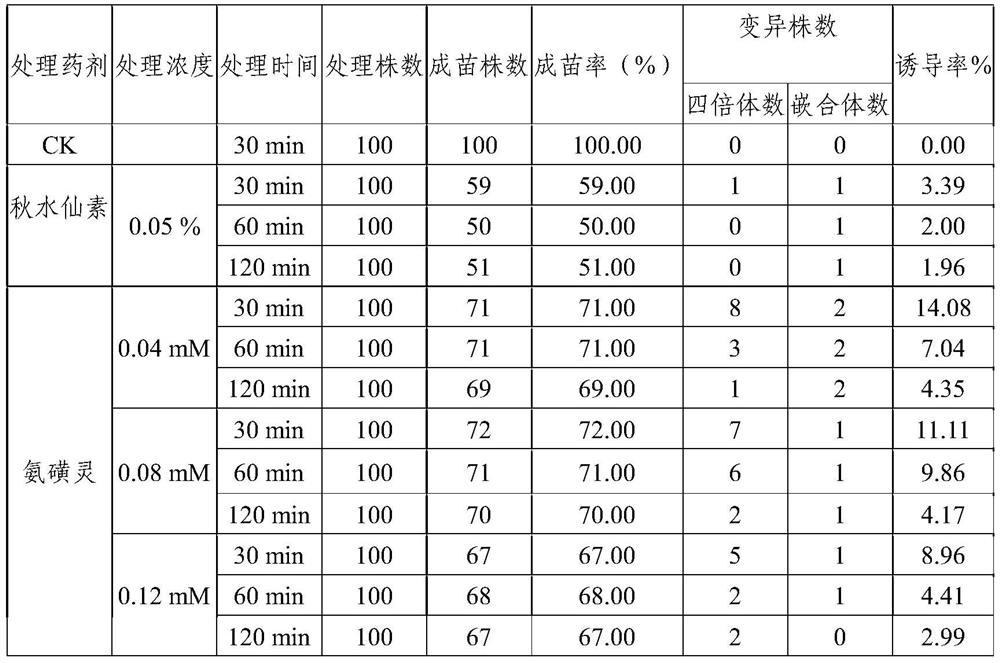A kind of induction method of rubber grass tetraploid plant
A rubber grass, tetraploid technology, applied in the field of plant genetics and breeding, can solve the problems of rubber grass damage, low induction rate, etc., to achieve the effect of reducing chimerism, increasing mutation rate, and improving seedling rate
- Summary
- Abstract
- Description
- Claims
- Application Information
AI Technical Summary
Problems solved by technology
Method used
Image
Examples
Embodiment 1
[0025] The present embodiment provides a kind of rubber grass tetraploid plant induction method (process diagram sees figure 1 ), the method includes the following steps:
[0026] Step 1: Soak rubber grass seeds in 1% hydrogen peroxide and sterilize them for 1 hour, then rinse them with water, put them into a petri dish with filter paper to germinate, and when the seeds germinate and the radicle grows to about 5-10 mm, perform mutagenesis treatment;
[0027] Step 2: Soak the rubber grass seedlings in 0.04mM oryzalin solution for 30 minutes, then wash them with water for 4 times, and transplant them to culture soil (vermiculite + peat soil = 3:1) for cultivation. The cultivation temperature is 18 ~ 26°C, 16 hours of light (natural light + 50klux fluorescent light supplementary light);
[0028] Step 3: After the plant grows to 5-7 leaves, use flow cytometry or root tip cell chromosome pressing technology to screen and identify the tetraploid plant of rubber grass.
Embodiment 2
[0030] The present embodiment provides a kind of rubber grass tetraploid plant induction method, and the method comprises the following steps:
[0031] Step 1: Soak rubber grass seeds in 1% hydrogen peroxide and sterilize them for 1 hour, then rinse them with water, put them into a petri dish with filter paper to germinate, and when the seeds germinate and the radicle grows to about 5-10 mm, perform mutagenesis treatment;
[0032] Step 2: Immerse the rubber grass seedlings in 0.04mM oryzalin solution for 1 hour, then wash them with water for 4 times, and transplant them to culture soil (vermiculite + peat soil = 3:1) for cultivation. The cultivation temperature is 18 ~ 26°C, 16 hours of light (natural light + 50klux fluorescent light supplementary light);
[0033] Step 3: After the plant grows to 5-7 leaves, use flow cytometry or root tip cell chromosome pressing technology to screen and identify the tetraploid plant of rubber grass.
Embodiment 3
[0035] The present embodiment provides a kind of rubber grass tetraploid plant induction method, and the method comprises the following steps:
[0036] Step 1: Soak rubber grass seeds in 1% hydrogen peroxide and sterilize them for 1 hour, then rinse them with water, put them into a petri dish with filter paper to germinate, and when the seeds germinate and the radicle grows to about 5-10 mm, perform mutagenesis treatment;
[0037] Step 2: Soak the rubber grass seedlings in 0.08mM oryzalin solution for 30 minutes, then wash them with water for 4 times, and transplant them to culture soil (vermiculite + peat soil = 3:1) for cultivation. The cultivation temperature is 18 ~ 26°C, 16 hours of light (natural light + 50klux fluorescent light supplementary light);
[0038] Step 3: After the plant grows to 5-7 leaves, use flow cytometry or root tip cell chromosome pressing technology to screen and identify the tetraploid plant of rubber grass.
PUM
 Login to View More
Login to View More Abstract
Description
Claims
Application Information
 Login to View More
Login to View More - R&D
- Intellectual Property
- Life Sciences
- Materials
- Tech Scout
- Unparalleled Data Quality
- Higher Quality Content
- 60% Fewer Hallucinations
Browse by: Latest US Patents, China's latest patents, Technical Efficacy Thesaurus, Application Domain, Technology Topic, Popular Technical Reports.
© 2025 PatSnap. All rights reserved.Legal|Privacy policy|Modern Slavery Act Transparency Statement|Sitemap|About US| Contact US: help@patsnap.com


